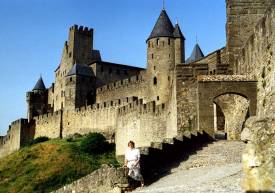Chateau at Carcassonne
 Carcassone is breathtaking. Of all the castles in the world, it most closely resembles the fairytale image of what a medieval castle should look like. It's also vast - it's a whole city-within-a-castle. As you approach, you'll think you've wandered into a film set, and Carcassonne was indeed used for several scenes in Robin Hood: Prince of Thieves. It's in the Aude department, near the Mediterranean and the Pyrenees, and has a very different history from the Renaissance pleasure-palaces of the Loire valley.
Carcassone is breathtaking. Of all the castles in the world, it most closely resembles the fairytale image of what a medieval castle should look like. It's also vast - it's a whole city-within-a-castle. As you approach, you'll think you've wandered into a film set, and Carcassonne was indeed used for several scenes in Robin Hood: Prince of Thieves. It's in the Aude department, near the Mediterranean and the Pyrenees, and has a very different history from the Renaissance pleasure-palaces of the Loire valley.
For eight millennia, Carcassonne has been at the intersection of two major traffic routes: from the Atlantic to the Mediterranean and from the Massif Central to Spain. The earliest signs of settlement have been dated to 3500 BC, and parts of the ramparts visible today date back to Roman times. The Romans were thrown out in 426 AD by Theodoric II, King of the Visigoths. The Visigoths added to the Roman fortifications and were able in 508 to see off Frankish King Clovis.
A hundred years later, the Saracens, who'd already conquered North Africa and Spain, crossed the Pyrenees and took Carcassonne from the Visigoths in 726. Just as the Saracens were getting comfortable in Carcassonne, they were driven out by King Pippin (The Short) who then drove them right out of France, despite his cute name. Three hundred years later, whilst William the Conqueror was looking for a holiday home in England, the Trencavel family inherited Carcassonne and started building the Château Comtal and the Basilica of Saint-Nazaire.

In the thirteenth century, Carcassone became a stronghold of the Cathar heresy. The Cathars were gnostics, which is quite complicated to explain, but basically, they were against opulence, materialism and power. This obviously set them at odds with the prevailing Catholic Church, who sent Simon de Montfort to put an end to all this nonsense. By 1247, Carcassonne was under the rule of the Kingdom of France. The last test of the city's fortifications was in 1355, during the Hundred Years' War. Edward the Black Prince had built up quite a reputation for capturing cities, but try as he might, he couldn't get into Carcassonne. Ed took it badly, and completely destroyed the unfortified Lower Town before marching off in a huff.
No longer of strategic importance, Carcassonne fell into decline. Napoleon even removed it from the list of old-places-we-ought-to-look-after, and in 1849, the French government decided to demolish it. Fortunately, there was a national outcry, and architect Viollet-le-Duc was commissioned to rebuild the fortress. Not all of le- Duc's methods would meet today's conservation standards; he demolished any buildings adjoining the ramparts, however old, and he opted for the characteristic but completely inauthentic pointy towers we see today. Still, if it weren't for le-Duc, Carcassonne would now probably be a retail park.
The medieval city and ramparts are open all year round, and admission is free. In addition, there are various museums, guided tours and even displays by the city's resident (tame-ish) eagles. For the supernaturally-inclined, there are (allegedly) several resident ghosts, including a poltergeist who throws candles and a fat man who stands and stares at tourists. Just stare back.